- Joined
- Sep 5, 2013
- Messages
- 3,207
I was asked by a friend and colleague recently if I could make a custom pointing iron for him. He’s a stonemason specializing in architectural restoration and conservation, and pretty fussy about his mortars and joints. The “new world style” of beading tools for lack of a better description just don’t do it for him so he wondered if I could build one based on a traditional Scottish pattern.
The idea here with this style of iron is that the straight, broad blade can be drawn along a straightedge for coursed ashlar work where a really tight joint is desired. The profile, a semi-circular bead shape, is pretty typical of late 1800’s stonework at least in these parts. I made him two slightly different sizes — 5/16” width and 1/4” width — but both use the same 3/8” thick blade stock.
For metal I just went with a 1018 cold rolled. It won’t wear the best, but as these are kind of prototype designs we aren’t too worried about that for now. The quickest way for me to break the blanks out was to chain drill around the shapes and clean up afterwards. It looks ugly but it does work, and fairly quickly too.
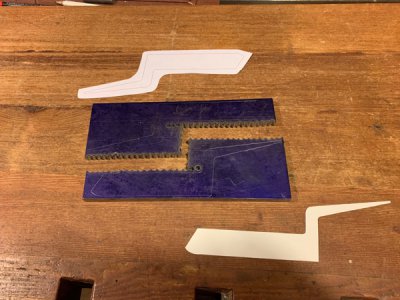
A while back there was a thread asking if stresses in cold rolled material were something to be concerned about. Well, this is a pretty good illustration in real time — with the two blanks removed from the one piece of bar and placed edge to edge, the combined bow was just under twenty-five thousandths.
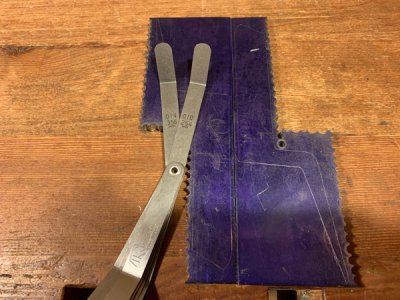
I spent a lot of time trying to figure out various ways to hold the work during different operations. Here’s one blank on the clamping plate for shaping the tang for the wooden handle.
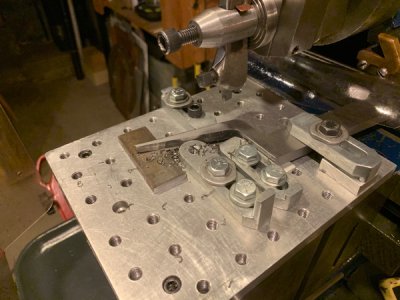
The bead profile was roughed out on the shaper as well using my basic round-nose tool. It won’t do the whole shape in one sweep, but nibbling small cuts to gradually sneak up to the line worked really well. You have to stay focussed though — at 60 strokes per minute a mental slip-up in which direction to tweak the crank can suddenly become very exciting!
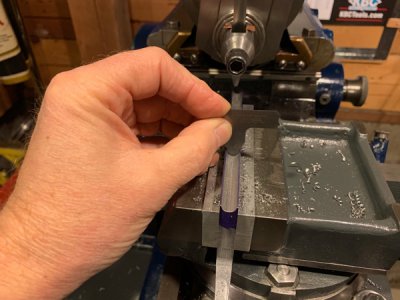
I use my clamping plate on my bandsaw as well, it’s really handy for cutting odd-shaped parts.
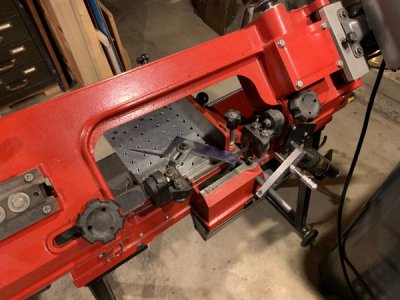
Here’s the two irons pretty much finished. I tuned up the prows by hand using a round chainsaw file and also eased the sharp heel a tad. This is the same shape as the sample he gave me to work from, so I copied it faithfully.
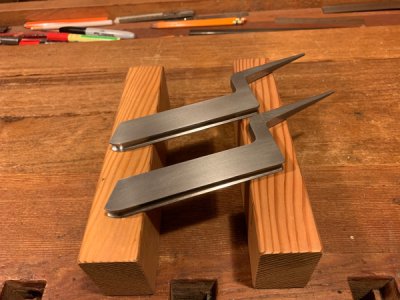
And here with the handles mounted. I’ve always been a little non-plussed with tang hole drilling in the past but this time I thought of using a step drill (uni bit, Christmas tree bit, whatever, the kind you use for sheet metal). That worked as slick as can be and the tangs drive in very solidly.
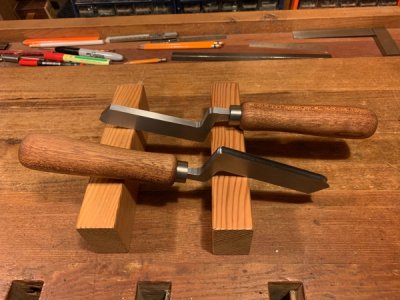
So that’s that. My friend will get to try them out within the month I expect, so I’ll see how they perform. Thanks for looking!
-frank
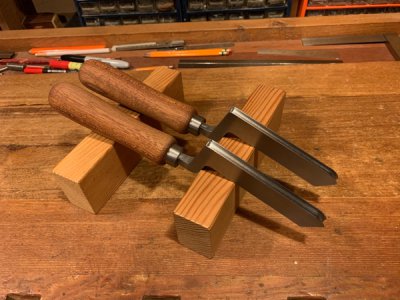
The idea here with this style of iron is that the straight, broad blade can be drawn along a straightedge for coursed ashlar work where a really tight joint is desired. The profile, a semi-circular bead shape, is pretty typical of late 1800’s stonework at least in these parts. I made him two slightly different sizes — 5/16” width and 1/4” width — but both use the same 3/8” thick blade stock.
For metal I just went with a 1018 cold rolled. It won’t wear the best, but as these are kind of prototype designs we aren’t too worried about that for now. The quickest way for me to break the blanks out was to chain drill around the shapes and clean up afterwards. It looks ugly but it does work, and fairly quickly too.

A while back there was a thread asking if stresses in cold rolled material were something to be concerned about. Well, this is a pretty good illustration in real time — with the two blanks removed from the one piece of bar and placed edge to edge, the combined bow was just under twenty-five thousandths.

I spent a lot of time trying to figure out various ways to hold the work during different operations. Here’s one blank on the clamping plate for shaping the tang for the wooden handle.

The bead profile was roughed out on the shaper as well using my basic round-nose tool. It won’t do the whole shape in one sweep, but nibbling small cuts to gradually sneak up to the line worked really well. You have to stay focussed though — at 60 strokes per minute a mental slip-up in which direction to tweak the crank can suddenly become very exciting!

I use my clamping plate on my bandsaw as well, it’s really handy for cutting odd-shaped parts.

Here’s the two irons pretty much finished. I tuned up the prows by hand using a round chainsaw file and also eased the sharp heel a tad. This is the same shape as the sample he gave me to work from, so I copied it faithfully.

And here with the handles mounted. I’ve always been a little non-plussed with tang hole drilling in the past but this time I thought of using a step drill (uni bit, Christmas tree bit, whatever, the kind you use for sheet metal). That worked as slick as can be and the tangs drive in very solidly.

So that’s that. My friend will get to try them out within the month I expect, so I’ll see how they perform. Thanks for looking!
-frank


